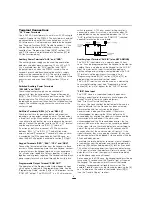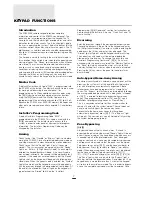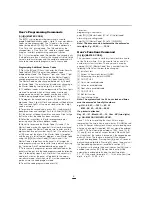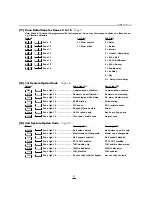
17
[14] Reporting Codes for Opening
(Disarming) with Access Codes 9 to 16
See section [13] for further information.
[15] Reporting Codes for Miscellaneous
Functions
The reporting codes programmed in this section include the
Partial Closing code described in section [11], Alarm and
Restoral codes for the keypad zones and the Periodic Test
reporting code (every 1 to 99 days). The Periodic Test cycle
time is set in Section [22] and reporting time of day is set in
section [23].
The reporting codes are programmed in the following order.
Partial Closing
• Keypad Panic Alarm [P]
• Keypad Fire Alarm [F]
• Keypad Auxiliary Alarm [A]
• Keypad Panic Restoral [P]
• Keypad Fire Restoral [F]
• Keypad Auxiliary Restoral [A]
• Periodic Test Transmission
[16] Zone Definitions for Zones 1 to 8
As in the reporting codes, once this section number is
entered, 8 two digit numbers are required. Each 2 digit
number entered describes how a zone will operate. The 8
two digit numbers entered correspond to zone definitions for
zones 1 to 8.
The first digit entered determines whether the zone will be
audible or silent and whether it will have a fast or slow
response time (zone response time may be altered in
section [22]). The second digit determines the zone type
(i.e. delay, instant, interior, or 24 hour zone).
1st DIGIT
2nd DIGIT
0 = Slow, audible
0 = Delay
1 = Slow, silent
1 = Instant
2 = Fast, audible
2 = Interior
3 = Fast, silent
3 = Interior Home-Away
4 = 24 Hour..bell
5 = 24 Hour..bell/buzzer
6 = 24 Hour buzzer
7 = Double delay
8 = 4 X Delay
9 = Day
A = Delay Home-Away
All of the zone types, except the 24 hour zones and day
zone, have an exit delay (see section [22] for setting exit
and entry delay times). All zones with an exit delay may be
tripped during the exit delay without creating an alarm.
If you are not familiar with the different zone types, test them
to see how they function. To avoid confusion, be sure the
exit time has expired before creating alarms (“Ready” light
will go out when exit time has expired). Set short exit and
entry times for testing.
[0] Delay Zone
is used for the exit/entry door. It has an exit
delay and an entry delay. The exit delay starts as soon as
the panel is armed. The zone may be opened and closed
during the exit delay without creating an alarm. After the exit
delay has expired, an open on the zone will cause the entry
delay time to start. During the entry time the keypad buzzers
will sound steady. If the panel is disarmed before the entry
time expires no alarm will be generated. Type [7] and [8]
Delay zones are used where a longer entry delay time is
required such as with a garage door. With these two zone
types the exit delay is the same as the type [0] delay.
However, the entry delay times are either 2 or 4 times as
long (set the exit delay time for the maximum required).
[1] Instant Zone
is normally used for door and window
contacts. This zone has a normal exit delay but will generate
an alarm immediately when opened after the exit delay.
[2] Interior and [3] Interior Home-Away Zones
are used
with interior motion detectors. Both zones have standard
exit delays. They also have entry delays provided that a
delay zone has been tripped first. If the building is entered
without coming through the normal delay entrance and a
type [2] or [3] zone is tripped, an immediate alarm will be
generated. The type [3] zone is bypassed if the system is
armed using the [
Q
][9] command (at home arming) or if a
Delay zone is not tripped during the exit delay.
[4], [5] and [6] 24 Hour Zones
provide different audible
variations. 24 Hour Zones are always active and create an
alarm whether or not the panel is armed. Type [4] always
rings the bell or siren. Type [5] rings the bell or siren when
armed and the keypad buzzer when disarmed. Type [6]
always sounds the keypad buzzer.
[7] Double Delay and [8] 4 x Delay Zones
feature entry
and exit delay that are 2 times and 4 times as long as a
normal entry or exit delay. They would be used for zones
that require an extra long entry or exit delay time; for
example, an overhead garage door.
[9] Day Zone
is a variation of a 24 hour zone. It operates as
a type [5] zone by ringing the bell or siren when armed and
the keypad buzzer when disarmed (2 beeps every 10
seconds; pressing any key silences keypad buzzer).
However, a trouble transmission (programmed in section
[10]) is sent when the system is disarmed rather than an
alarm transmission (programmed in section [05] and/or
[06]).
[A] Delay Home-Away Zone
operates the same way as the
Type [3] zone with the following exception. If the zones are
not bypassed manually ([
Q
] [1] bypassed or [
Q
] [9] armed),
or automatically (not opening a delay zone during the exit
delay), and the zone is tripped, a standard entry delay will
be initiated. This allows the user to disarm the system
preventing false alarms inside the premises. Upon entering
[
Q
] [1] to activate Home-Away zones, the type [A] zone will
have a standard exit delay.
[17] Zone Definitions for Zones 9 to 16
1st DIGIT
2nd DIGIT
0 = Slow, audible
0 = Delay
1 = Slow, silent
1 = Instant
2 = Interior
3 = Interior Home-Away
Note:
4 = 24 Hour..bell
Zones 9-16 cannot be
5 = 24 Hour..bell/buzzer
Summary of Contents for PC3OOO
Page 1: ...INSTALLATION MANUAL PC3OOO Version 7 51...
Page 40: ...HOOKUP DIAGRAMS 36...
Page 44: ...29000543 R7...






























